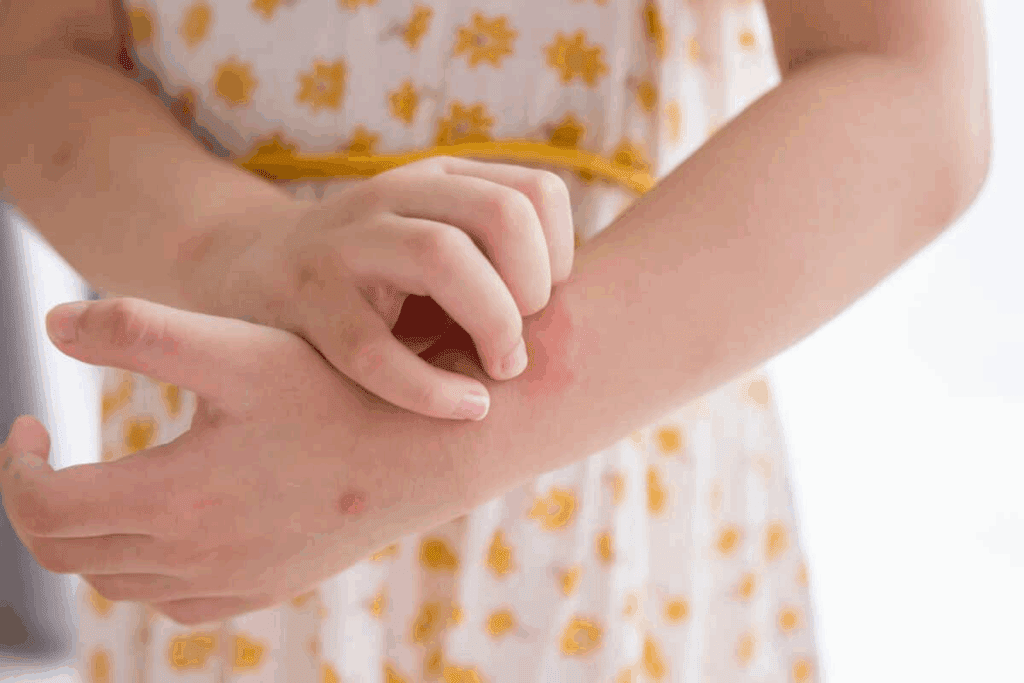Last Updated on November 20, 2025 by Ugurkan Demir

Anemia is when there are fewer healthy red blood cells or less hemoglobin. This means less oxygen gets to the body’s tissues. In kids, this can show up in many ways, affecting their health and happiness. At Liv Hospital, we know how important it is to catch anemia symptoms early in children.
Children, during their growing years, are more likely to get anemia. Signs include pale skin, feeling tired, being easily upset, feeling weak, headaches, and breathing hard. In serious cases, it can cause a fast heart rate or swollen hands and feet. We aim to offer top-notch care and support to families. We help them spot the warning signs and get the right treatment.

Anemia in children is a serious issue that needs early attention. It happens when there aren’t enough healthy red blood cells. These cells are key to carrying oxygen to the body’s tissues.
Anemia is when the body lacks red blood cells or doesn’t carry enough oxygen. In kids, it can cause tiredness, weakness, and affect their brain function. This can harm their growth and happiness.
Iron deficiency anemia is the most common type in kids. It’s often due to not getting enough iron from food, chronic illnesses, or genetic issues.
Anemia can be hard to spot, even in mild cases. That’s why regular health checks are so important.
Anemia is a big health problem for kids in the U.S. The Centers for Disease Control and Prevention (CDC) says many kids are affected. This is true for kids from low-income families or those who can’t get to the doctor.
Knowing about anemia helps us spot it early in kids. This way, we can start treatment right away.

Anemia in kids can come from many sources. It’s important to find out why for the right treatment. We’ll look at the main reasons, like iron deficiency, inherited blood disorders, chronic diseases, and blood loss.
Iron deficiency anemia is very common in kids. It happens when the body doesn’t have enough iron to make hemoglobin. Hemoglobin is a protein in red blood cells that carries oxygen.
This condition can happen if kids don’t get enough iron in their food. It can also happen during growth spurts or if they lose a lot of blood.
Key factors contributing to iron deficiency anemia include:
Inherited blood disorders like sickle cell disease and thalassemia are big causes of anemia in kids. These genetic conditions affect how hemoglobin is made or structured, leading to anemia and other problems.
Sickle cell disease makes red blood cells break down, causing anemia. Thalassemia affects hemoglobin production, leading to severe anemia in some cases.
Chronic diseases can also cause anemia in kids. Conditions like chronic kidney disease, cancer, and autoimmune disorders can make it hard for the body to make red blood cells or hemoglobin.
| Chronic Disease | Effect on Red Blood Cells |
| Chronic Kidney Disease | Reduced erythropoietin production, leading to decreased red blood cell production |
| Cancer | Chemotherapy and disease-related inflammation can suppress red blood cell production |
| Autoimmune Disorders | Inflammation and immune system dysregulation can affect red blood cell production and survival |
Blood loss is a big cause of anemia in kids. It can happen from trauma, surgery, or conditions like bleeding in the gut. Other less common causes include bone marrow disorders and certain medicines.
Knowing the causes of anemia is key to treating it in kids. By finding out why a child has anemia, doctors can create a treatment plan. This helps prevent long-term health problems.
Changes in a child’s appearance can signal anemia, a common condition worldwide. Anemia brings visible symptoms that parents and caregivers should watch for. This ensures early detection and treatment.
One key sign of anemia in kids is pale skin. This paleness is often seen in the face, lips, and nail beds. Some kids may also have a yellowish or pale tint to their skin, known as jaundice. This is more common in certain types of anemia.
Other skin color or texture changes can happen, too. For example, kids with anemia might have cold hands and feet. This is a sign of poor circulation due to fewer red blood cells.
Other signs in a child’s appearance might suggest anemia. These include:
Spotting these signs early is key to diagnosing and treating anemia in children. If you see any of these changes in your child, it’s vital to talk to a healthcare professional.
Children with anemia may show signs of low energy and mood changes. These signs can start small but grow as the condition worsens.
Anemia often causes kids to feel very tired and weak. They might feel dizzy or lightheaded, which can happen when they stand up fast. This tiredness can make it hard for them to play or do their schoolwork.
Children with anemia get tired quickly, even when they’re just playing. This constant tiredness is a big sign that something is wrong and needs to be checked.
Anemia can also make kids more irritable and moody. Not enough oxygen and nutrients to the brain can make it feel anxious or withdrawn. Parents might see their child getting easily upset or having quick mood swings.
| Symptom | Description | Possible Impact |
| Fatigue | Persistent feeling of tiredness | Reduced participation in activities |
| Irritability | Increased sensitivity and frustration | Mood swings and behavioral changes |
| Weakness | Lack of physical strength | Difficulty in performing daily tasks |
By spotting these signs of anemia, parents and caregivers can get help early. This can stop bigger problems and make the child’s life better.
Anemia in children can cause heart and lung problems. This includes shortness of breath and a fast heart rate. Without enough red blood cells or hemoglobin, the body can’t get enough oxygen. This leads to symptoms affecting the heart and lungs.
Children with anemia might find it hard to breathe, even when doing simple things. This is because their body tries to get more oxygen by breathing faster. A study on the National Center for Biotechnology Information website shows that anemia can really affect a child’s health.
Seeing a child struggle to breathe can be scary. It’s important to know that this symptom can mean something serious, like anemia.
Anemia can also make a child’s heart beat fast or irregularly. Without enough hemoglobin, the heart works harder to get oxygen to the body. This can feel like palpitations or an irregular heartbeat.
A fast heart rate is normal sometimes, but it can also mean anemia. Parents should watch for this.
Older kids with anemia might find it hard to do physical activities. Their bodies can’t get enough oxygen to the muscles during exercise.
This can stop kids from playing sports or doing other fun activities. It can also hurt their social life and happiness.
| Symptom | Description | Impact on Children |
| Shortness of Breath | Increased breathing rate to compensate for a lack of oxygen | Limits physical activity and play |
| Rapid Heart Rate | The heart pumps more blood to meet oxygen needs | Can cause discomfort and palpitations |
| Exercise Intolerance | Decreased ability to participate in physical activities | Affects participation in sports and social activities |
Anemia affects more than just blood; it can also harm a child’s brain. When the brain doesn’t get enough oxygen, it can lead to serious symptoms. These symptoms can make daily life harder for kids.
The brain needs oxygen to work properly. Kids with anemia get less oxygen, causing big problems. Headaches and dizziness are common, making it hard to do everyday things.
Anemia can mess with a kid’s focus and learning. With less oxygen, the brain struggles, making school hard. Teachers and parents might see grades drop or more irritability.
| Symptom | Possible Effect on Children | Potential Intervention |
| Headaches | Discomfort, distraction, and decreased participation in activities | Medical evaluation, pain management strategies |
| Dizziness | Increased risk of falls, difficulty in maintaining balance | Safety precautions, vestibular rehabilitation |
| Concentration Issues | Poor academic performance, decreased productivity | Educational support, cognitive training |
Children with anemia might feel lightheaded and have balance problems. This makes them more likely to fall and get hurt. These issues can worry parents a lot.
Knowing about these signs helps us help kids with anemia. Finding and treating anemia early is key to keeping kids healthy and happy.
Anemia in young children can be hard to spot, but it’s key to catch it early. Infants and toddlers might not show the usual signs of anemia. So, parents and caregivers need to watch for any changes in their behavior or health.
One early sign of anemia in babies is poor feeding. They might not want to eat or have trouble eating because they’re tired or weak. This can cause them to grow slowly or not gain weight, which doctors can check during visits.
Babies who don’t get enough iron from breast milk or formula are more likely to get anemia. It’s important to make sure they get enough iron through food or supplements to prevent anemia.
Anemia can also slow down a child’s development. Kids with anemia might not reach milestones like sitting or walking on time. If a doctor thinks a child might have anemia, they can check their development and suggest tests.
Pica, or wanting to eat things like dirt or paint, can be a sign of anemia in young kids. This behavior is not only a symptom but also a risk for health problems if the items are harmful.
In very young kids, anemia can be hard to spot because its symptoms are not obvious. For example, cold hands and feet or jaundice in certain types of anemia are subtle signs.
To summarize the key signs of anemia in infants and toddlers, we have compiled the information into the following table:
| Signs/Symptoms | Description | Age Group |
| Poor Feeding | Less interest in feeding or difficulty feeding | Infants |
| Slow Growth | Poor weight gain or slow growth | Infants/Toddlers |
| Developmental Delays | Not reaching developmental milestones on time | Toddlers |
| Pica | Craving non-food items | Toddlers |
| Cold Extremities | Hands and feet are feeling cold | Infants/Toddlers |
| Jaundice | Yellowing of the skin and eyes | Infants/Toddlers |
Spotting these signs early can help get a child with anemia the right treatment quickly. This can greatly improve their health.
Anemia in children can sometimes be hidden, making regular tests key to catching it early. Mild anemia often doesn’t show symptoms, making it hard for parents to spot.
Children with mild anemia might not show clear signs. Routine check-ups are essential. They include hemoglobin tests that can find anemia before symptoms appear.
Being proactive about our children’s health is vital. We need to know the risk factors for anemia, even if they seem fine.
Some risk factors mean we should talk to our pediatrician about anemia tests. These include:
Spotting these risk factors early can help us act fast. Early detection is key to managing anemia effectively.
Regular tests for anemia are a big part of taking care of kids. The American Academy of Pediatrics suggests hemoglobin or hematocrit tests at certain ages to check for anemia.
| Age | Test Recommendation |
| 1 year | Hemoglobin or hematocrit test |
| Between 2-5 years | Annual screening for high-risk children |
| Adolescence | Screening during annual check-ups |
Regular tests can find anemia early, helping us treat it quickly. We should work with our child’s doctor to make sure they get the right tests.
By knowing the risks and being proactive about tests, we can protect our kids’ health. This ensures they get the care they need.
Knowing when to get medical help for your child is key, especially if they show signs of anemia. As a parent, knowing the red flags that mean you should act fast is vital. This ensures your child gets the care they need on time.
Some symptoms in children with anemia need quick action. These include:
If your child shows any of these signs, seeing a doctor right away is a must.
Before going to the doctor, it’s good to prepare by:
Being ready will help you have a better talk with your doctor.
At the doctor’s office, your child will get a physical check-up. The doctor might also ask for tests, like:
The doctor will then talk about what they found and suggest the best treatment.
If your child is found to have anemia, it’s important to follow the treatment plan and go to all follow-up visits. This is key to their recovery.
Managing childhood anemia needs a full plan. This plan should tackle the root causes and encourage healthy habits. We’ll look at ways to treat and prevent anemia in kids. This includes changing their diet, using supplements, and other steps based on their needs.
Iron deficiency is a big reason for anemia in kids. Iron supplements help fix this by boosting iron levels and making hemoglobin. It’s important to stick to the right dose to avoid too much iron, which can harm health.
It’s wise to talk to a doctor about treating iron deficiency anemia. They can help figure out the right amount and how long to take iron supplements.
Eating right is key to fighting anemia. Increasing iron intake with foods like red meat, beans, and fortified cereals helps. Vitamin C boosts iron absorption, so eating foods like citrus fruits with iron-rich foods is good.
Other anemia types need different treatments. For example, anemia from chronic diseases might mean managing the disease. Inherited blood disorders might need special treatments or blood transfusions.
| Type of Anemia | Treatment Approach |
| Iron Deficiency Anemia | Iron supplements, dietary modifications |
| Anemia of Chronic Disease | Managing the underlying chronic disease |
| Inherited Blood Disorders | Specific medical interventions, blood transfusions |
Different ages have different nutritional needs. For babies, breastfeeding is best because it provides enough iron. Older kids need a balanced diet with iron-rich foods and vitamin C.
Knowing what each age group needs and following good dietary advice helps prevent and treat anemia.
It’s important to spot anemia in kids early. This way, we can start treatment right away. We’ve talked about how to know if a child has anemia, like changes in how they look and how they act.
With the right treatment, kids with anemia can live active, healthy lives. Knowing what causes anemia and how to treat it is key. By acting fast, we can stop problems and help kids grow strong.
To wrap it up, anemia in kids needs our care and attention. Being informed and watching for signs can really help. Early action and treatment are essential for kids to do well.
Signs include paleness, fatigue, and weakness. Children might also be irritable, breathe short, or have a fast heart rate. Infants and toddlers might not eat well, grow slowly, or have cravings for non-food items.
Anemia can be due to iron deficiency, inherited blood disorders, chronic diseases, or blood loss. Knowing the cause is key to treating it effectively.
Doctors use blood tests to check hemoglobin levels. They might also do a physical exam and look at the child’s medical history.
Yes, mild anemia might not show symptoms. It’s important to screen children regularly, even if they seem fine. This is true for kids with a diet low in iron or a family history of anemia.
Treatment includes eating more iron-rich foods and taking supplements. Doctors also look for and treat the reasons for iron deficiency.
Eating foods high in iron, like red meat, beans, and fortified cereal, helps. Vitamin C can also help the body absorb more iron.
Untreated anemia can cause developmental delays and affect thinking skills. It also makes kids more likely to get sick. Finding and treating anemia early is very important.
Parents can help by making sure their child eats well, takes supplements, and goes to doctor’s appointments.
Call a doctor right away if your child has trouble breathing, chest pain, or is very tired.
While some causes can’t be stopped, a balanced diet and regular check-ups can help. Treating conditions early also reduces risk.
Subscribe to our e-newsletter to stay informed about the latest innovations in the world of health and exclusive offers!